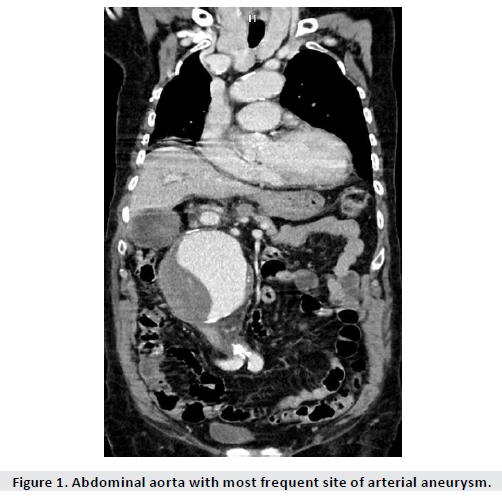Clinical images - Imaging in Medicine (2020) Volume 12, Issue 6
Yin - yang: the reason for abdominal pain?
Ines Vieira Santos*, Lucas S, Escária S
Interdisciplinary Centre for the Study of Human Performance, Faculty of Human Kinetics, University of Lisbon, Estrada da Costa, 1495-688, Cruz Quebrada, Portugal.
- Corresponding Author:
- Ines Vieira Santos
Interdisciplinary Centre for the Study of Human Performance
Faculty of Human Kinetics, University of Lisbon
Estrada da Costa, 1495-688, Cruz Quebrada, Portugal
E-mail: inesvieira.santos@gmail.com
Abstract
The abdominal aorta is the most frequent site of arterial aneurysm. Abdominal aortic aneurysm is defined as segmental dilation, involving all vascular layers, with a diameter ≥ 50% of the expected diameter. They are more frequent in males and their prevalence increases with age. Risk factors include age, smoking, atherosclerosis, arterial hypertension, and family history of abdominal arterial aneurysm.
Keywords
Abdominal aortic aneurysm ■ Abdominal pain ■ Aneurysmal dilation
The abdominal aorta is the most frequent site of arterial aneurysm. Abdominal aortic aneurysm is defined as segmental dilation, involving all vascular layers, with a diameter ≥ 50% of the expected diameter. They are more frequent in males and their prevalence increases with age. Risk factors include age, smoking, atherosclerosis, arterial hypertension, and family history of abdominal arterial aneurysm.
The authors present a clinical case of an 87-year-old man with a history of prostate adenocarcinoma and biliary lithiasis. He went to the emergency department for epigastric abdominal pain, without irradiation, associated with hematemesis. He made an upper digestive endoscopy, which showed duodenal ulceration. To exclude complications, an abdominal computed tomography scan was performed, which incidentally showed a massive 14 cm x 11 cm aneurysmal dilation with a thick mural thrombus, with irregular contours with lobulation in its anterior and posterior slope, being a warning sign for an imminent rupture. It was proposed for emergent surgery that the patient denied. He died in the following days.
Most abdominal aortic aneurysms remain asymptomatic until rupture and are discovered incidentally on objective examination or on complementary diagnostic tests. This patient had no risk factors for the development of aortic aneurysm. The surgical indication exists when the abdominal aortic aneurysm is greater than 5.5 cm. After aneurysm rupture, mortality is high (FIGURE 1).



